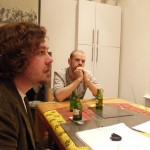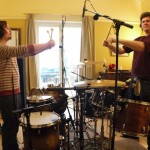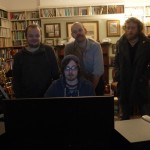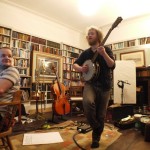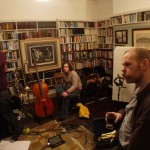Today we were very much at home to Mr Bang and Mr Crash as Biff’s (even taller) brother Paddy joined us to help Tom lay down some extra percussion parts. The two faced each other across a fearsome array of drums (an evil marriage of both their kits), beaters clutched like Viking pace-setters looming over a trembling galley of rowers. Needless to say, they made an unholy racket.
Meanwhile the rest of us have been polishing off other bits and pieces – arranging string parts, working out additional vocal harmonies and so on. It’s been hugely satisfying to get out the red pen and cross so much off our to-do list. For a long time we seemed to spend all our free hours adding new ideas, but now we’re striking them out with a near fanatical zeal.
At the end of the evening we listened through the tracks and tried out different orders, and I think we’ve narrowed it down to two finalists.
We are now very close…
Around The Horn
I thought it might be interesting to get Biff Roxby’s take on this recording project, as his brass parts have become something of a signature sound in our tunes. So I asked him some questions…
You’re often described as a “one man trombone army” and have become one of the most remarked upon elements of The Bedlam Six live show. How does your performance and technique differ in the studio compared to onstage?
With the Bedlam Six, my live performance isn’t just about playing. There’s a lot of physicality involved and I try to balance this with my playing so that the quality doesn’t suffer. Jumping around and, ahem, “rocking out” doesn’t mix too well with playing a brass instrument, so I keep the movement to a minimum when playing solos or tricky lines. In the studio I can be much more considered in my approach and can throw in more subtlety and intricacy. When you’re playing live you only get one chance at the part, so I often simplify to make it work. I also tend to play louder live – generally because monitoring is a problem on a noisy stage such as ours, but also sometimes because I’m full of adrenalin (and beer).
What you do is very physically demanding. Is there a danger of doing yourself damage and jeopardising future performances? Do you take precautions (as it were)? Is there any sort of studio regime or discipline you subscribe to?
I’ve split my lip a few times playing live with Bedlam, which can take a good two or three days to heal properly. Not ideal if you’re on tour or in a session the day after. A lot of warming up and practice is required to strengthen the lip. I’m quite strict with myself about this, though not as much as I should be. You can always do more.
My other major problem is playing too hard or too physically and therefore pulling muscles in my abdomen, which feels rather like a hernia. Again, the only way to combat this is by exercising and practicing. Breathing exercises help a lot with that.
I have some minor nerve damage in my lower lip, but luckily it doesn’t affect my playing too much as long as I keep up a good training regime. I also try and avoid any numbing injections at the dentist, as in some cases these can cause muscle problems in the lips. Fillings without anaesthetic aren’t fun, but I really like playing trombone.
There’s a danger that if I don’t take care of myself there will come a time where my lips won’t heal correctly anymore and I won’t be able to play properly or, even worse, at all.
What are the key factors to keep in mind when micing up brass?
Over the last few years Dan and I have tried at least thirty different ways of capturing trombone in the studio, using condensers, ribbons and dynamics in a variety of positions. Condensers tend to have too quick a response for close micing and can often pick up too much of the mechanical noises of the bass trombone – it has two valves that make a bit of a clank when I’m really going for it. The Reslo ribbon mic we’ve tried before sounds lovely and warm, but comes at the expense of any detail in the high end.
More recently Dan and I started a mobile recording business, WR Audio, and invested in several really awesome large diaphragm dynamic mics – all of which are widely used as brass/horn mics, as well as for many other things.
Another important consideration is the angle at which you play into the close mic. We’ve tried several different approaches. I’m generally presenting the trombone’s bell about a foot from the close mic, often less, so angling off-axis to the diaphragm can really change the tone. On axis, mics pick up more of the high end; the further off axis you go, the more of a roll-off you get from those higher frequencies. My standard position during this session is between twenty and forty-five degrees of axis, though we had some great results at ninety degrees to the diaphragm.
After testing all of our options for the close and room mic at various separations and angles, we eventually settled on two setups for the current recording session:
- Bass trombone – Sennheiser MD421 as a close mic for the direct sound, with a Neumann KM184 about three feet away to capture more of the character of the room.
- Tenor trombone – Beyer dynamic M-81 for a close mic, with the same Neumann for the room.
The 421 captures all the warmth of my bass ‘bone and does a bang-up job of getting all the crisp attack in there as well. I also like it because it looks like a space gun (see picture in the gallery opposite).
The M-81 proved better for tenor – the 421 crispness was a little too shrill for the more prominent attack of a tenor ‘bone. This mic looks more like a small electric razor.
The Neumann is just a beautiful microphone and works superbly to capture that more roomy sound, without losing any of the detail in the tone of the instrument. The Neumann looks like a pack of Polos, but doesn’t taste nearly as minty.
We tried several other microphones for the direct sound, including a Shure SM7B and an ElectroVoice RE-320. Both are great mics for live trombone. In the case of the RE-320 it makes monitoring my sound infinitely easier due to its natural presence towards the higher end of the frequency spectrum.
The eventual choices were made purely through preference. In another session we’ll almost definitely try something else.
You also play cello on Youth. I imagine that’s a whole other world of acoustic difficulties. Or is it simply a case of shoving a mic in the F-hole (if you’ll pardon my vulgarity)?
Haha, you stay away from my F-hole! But really, separation is important to get a good studio cello sound. Solo celli are often recorded in large, ambient spaces and in those situations you’ll rarely find a mic closer than eight feet from the performer. They can sometimes be upwards of forty feet away. In Bedlam recordings, however, my cello parts are mostly for texture with a few little moments poking through the mix, so all we really need is to capture a good tone and make sure I play it well.
Dan and I have tried a couple of techniques – a matched pair of Neumann KM184s in an X-Y configuration was the first port of call. We ended up placing the pair about four to five feet away and at about two feet off the ground. This produced a lovely sound, but with a little too much of the room for what we wanted. We simplified a bit and went with a single KM184 at the same height, but only two feet away. This struck the balance we were after and even surprised me by capturing less of the scratchy, upper partials that so often plagues the sound of the cello when recorded close up.
I think we’ll still try some more methods, probably in a more acoustically dead space to allow for further separation.
You’ve worked with all sorts of bands, from Liz Green to Elbow. How have you found this recording process compared to others you’ve worked on?
Everyone records differently. It’s a very personal process that has to be right for the artist or group in question. In the Bedlam studio there’s a lot of room for experimentation because we’re doing everything ourselves and have had a solid three weeks to record this album.
Recording for other people is usually a case of working to a much shorter deadline. Usually I’ll be trying to achieve an idea that they’ve already had and getting a performance they’re happy with. In our current Bedlam session I’ve been able to record something two weeks ago and come back to it with different ideas – not so in other sessions, where once it’s done it’s done.
When playing for other people it’s also all over quite quickly. The longest I’ve spent playing in a studio (other than the Bedlam one) is three days for Liz Green’s debut album. But most sessions I’ve done have been half a day or less.
It’s different with engineering. I’m there from start to finish, which can be anything from a day to two weeks. I’ve nicked a lot of ideas from studios in which I’ve played or engineered, but that’s the best way to learn – through experience (and thievery).
Any problems or surprises you’ve encountered? What advice would you give to someone embarking on this kind of project?
Dan is so thorough in his planning and logistics that there haven’t been any nasty surprises, just pleasant ones.
Advice? Being in your own custom house-studio is amazing. Experiment and have fun with it. Do it, do it now!
Any other thoughts?
When’s lunch?


